This paper analyzes the performance of routing protocols in vehicular ad hoc networks (VANETs) with roadside unit (RSU) infrastructure, addressing challenges posed by dynamic topologies and the need for reliable communication. The study examines various routing protocols, considering their effectiveness in urban scenarios while evaluating quality of service (QoS) metrics related to mobility and network density. Ultimately, the research aims to assist in selecting the most suitable routing strategy that incorporates RSUs for optimal performance.
![International Journal of Computer Networks & Communications (IJCNC) Vol.12, No.4, July 2020
DOI: 10.5121/ijcnc.2020.12402 19
PERFORMANCE ANALYSIS OF
ROUTING PROTOCOLS WITH ROADSIDE
UNIT INFRASTRUCTURE IN A VEHICULAR
AD HOC NETWORK
Safae Smiri, Abdelali Boushaba, Rachid Ben Abbou and Azeddine Zahi
Intelligent Systems and Applications Laboratory (LSIA), Faculty of Science and
Technology, Sidi Mohamed Ben Abdelah University, Fez, Morocco.
ABSTRACT
Vehicular ad-hoc networks (VANETs) represent a powerful and active field of research and have given rise
to many challenges related to routing protocols and communication problems with other vehicles or fixed
infrastructure called roadside units (RSU). The dynamic topology and the obstacles encountered in VANET
environments mean that the routing of data and the communication between vehicles is confronted with
many problems, and particularly in vehicular applications that require reliable communication and
satisfactory quality of service (QoS). This paper promotes the intention of infrastructure in an urban
scenario and studies the performance of routing protocols considering the constraint of mobility. This
leads us to analyze a wide range of routing protocols to ensure optimal coverage and continuous
connectivity, taking into consideration two types of data traffic in realistic environments that depend on
certain performance metrics. The paper also investigates which protocols provide better performance with
RSUs by ranking the results for QoS.
KEYWORDS
VANET, Intelligent Transportation System (ITS); Routing protocols, Roadside unit (RSU), Urban topology,
NS-2, VanetMobiSim, Quality of service (QoS).
1. INTRODUCTION
Over the last decade, intelligent transportation systems (ITSs) [1] have aimed to increase our
knowledge of traffic and mobility management by using information technologies and
communication for sustainable development in a quickly evolving world. Vehicular ad-hoc
networks (VANETs) [2] represent a domain of ITS that offers several innovative, reliable and
cost-effective applications that can be used in a wide range of services, from safety applications
to entertainment for drivers and passengers (internet access, etc.). Due to these applications,
advances in communications have played a major role in VANETs [3]. This has allowed the
deployment of three different architectures (Figure 1), including hardware and software structures
that provide communication between vehicles (V2V), offering flexible and less expensive
communication. In this strategy, the vehicles can communicate directly without infrastructure or
any installation on roads. However, due to the highly dynamic mobility involved, the network is
faced with frequent disconnection. Communication between vehicles and infrastructure or
roadside units (RSUs) (V2I/V2R) is, therefore based on a communication system using RSU
infrastructure or a base station installed at the edge of the road. The RSUs are connected via a
wireless or wired interface. The use of RSUs has the advantage of providing users with services](https://image.slidesharecdn.com/12420cnc02-200817043122/75/PERFORMANCE-ANALYSIS-OF-ROUTING-PROTOCOLS-WITH-ROADSIDE-UNIT-INFRASTRUCTURE-IN-A-VEHICULAR-AD-HOC-NETWORK-1-2048.jpg)
![International Journal of Computer Networks & Communications (IJCNC) Vol.12, No.4, July 2020
20
relating to internet access, road traffic and exchanging data between the car, garage or home, for
remote diagnostics. Another option is hybrid communication (V2V and V2I), which combines
two communication modes (V2V and V2I) in order to achieve effective communication. Many
factors need to be taken into account in order to meet the requirements for deploying different
types of vehicular applications [4], [5] or VANETs. The network connectivity with/without the
use of an RSU varies according to the density of the VANET environment; a high density allows
the network to be connected, while a low density has a longer transmission delay and high
communication failures. In addition, the Quality Of Service (QoS) requirements for real-time
applications include the end-to-end delay and packet transmission rate. For these reasons, the
design of an efficient routing protocol that meets all the requirements of a VANET is considered
a major challenge. Thus, improving reliability and reducing interference of the system in
VANET, need a promising routing protocol which should be evaluated using the standard IEEE
802.11p. There are several survey studies that compare routing protocols in VANETs, but the
majority compare only a small selection of protocols and consider only a limited number of
performance criteria and metrics, without taking into account the presence of RSUs. The
comparison and perception is not relevant and always remain to be discovered by the user. For
this reason, the deployment of infrastructure such as RSUs is insufficient in VANETs.
The main goal of this survey is to contribute a better comparison between a variety of known
routing protocols from different categories, involving RSUs and two types of traffic in an urban
topology. This kind of study can significantly affect daily life, and its requirements motivate our
interest. Our choice to study the environment mentioned above arises from the problems faced in
terms of communication [4] due to the high mobility, dynamic topology and scalability of a
VANET. Moreover, the density of the network varies, including very dense networks in urban
areas where communication is interrupted, leading to many conflicts in communication, and there
are therefore numerous problems to address. The aim of our comparative study is to select and
examine a variety of protocols that can support communication between vehicles and RSUs in a
complicated and highly dynamic environment, such as in a VANET. Thus, our review provides
researchers with the ability to choose the most relevant and promising protocol for a routing
strategy, depending on the communication with RSUs and to achieve a particular QoS.
The remaining of this paper is organized as follows. In Section 2, we review seven possible
protocols, and in Section 3, we discuss related works, describing the most popular studies of
VANETs. In Section 4, we pay particular attention to communication with RSUs by carrying
outa performance evaluation of a realistic mobility model for a VANET. Our performance
measures are described in Section 5, while Section 6 presents the experimental results and an
analysis. Finally, the conclusion and future works for researchers are presented in Section 7 and
8.
Figure 1. VANET architecture: (a) vehicle-to-vehicle communication (V2V); (b) vehicle-to-infrastructure
or RSU communication (V2I/V2R); (c)hybrid communication ( V2I and V2V)](https://image.slidesharecdn.com/12420cnc02-200817043122/75/PERFORMANCE-ANALYSIS-OF-ROUTING-PROTOCOLS-WITH-ROADSIDE-UNIT-INFRASTRUCTURE-IN-A-VEHICULAR-AD-HOC-NETWORK-2-2048.jpg)
![International Journal of Computer Networks & Communications (IJCNC) Vol.12, No.4, July 2020
21
2. OVERVIEW OF ROUTING PROTOCOLS
In the following paragraphs, we discuss the operating mechanism of routing protocols, the cons
and the pros of each one. All protocols are listed with their main advantages and disadvantages in
Table 1.
2.1. Topology-based routing protocols
The topology-based routing category uses the link information from the routing table to transmit
data from the source to the destination. We will present in the next three classifications of this
category.
2.1.1. Proactive routing protocol
An optimized link-state (OLSR) [6] is an optimized link-state routing protocol. It provides the
routes available during the route request due to its proactive nature. Each node exchange
topology information’s by defining its neighborhood-based on one and two hops, using HELLO
messages. From its neighbouring nodes (one hop), it chooses a set of multi-point relays (MPRs)
to reach all neighbours at the second hop. OLSR generates three control messages (HELLO,
topology control (TC) and multiple interface declaration (MID) messages) to maintain the routing
tables, as shown in Figure 2.
Multipath dynamic address routing (MDART) [7] is an advanced extension of the DART
protocol [8], which uses the choice of the shortest path in order to respond to changes in
topology. It guarantees the transmission of data in several ways, without generating additional
communication costs, based on the routing information stored for each node. The discovery of
the road and all available routes to the destination in MDART also involve no additional cost.
2.1.2. Reactive routing protocols (on demand)
The principle of a reactive protocol is to establish a route on-demand. When a node wishes to
transmit a packet, it makes a route request and searches for a path until it arrives at the
destination. In our work, we will discuss the AODV, AOMDV and DSR protocols in more detail.
A reactive scheme is illustrated in Figure 3.
Ad-hoc on-demand distance vector (AODV) [9] is a protocol that uses an on-demand
algorithm from Bellman-Ford. When a source node wants to send a packet, it determines an end-
to-end route to a destination. The AODV protocol has two well-defined mechanisms: discovery
of routes, and maintenance of routes. Route discovery occurs when there is no route to the
destination, while route maintenance is responsible for maintaining the route between the source
and the destination. The reactive protocol AODV is shown to be suitable for both high and low
densities of vehicles in [10], [11].](https://image.slidesharecdn.com/12420cnc02-200817043122/75/PERFORMANCE-ANALYSIS-OF-ROUTING-PROTOCOLS-WITH-ROADSIDE-UNIT-INFRASTRUCTURE-IN-A-VEHICULAR-AD-HOC-NETWORK-3-2048.jpg)
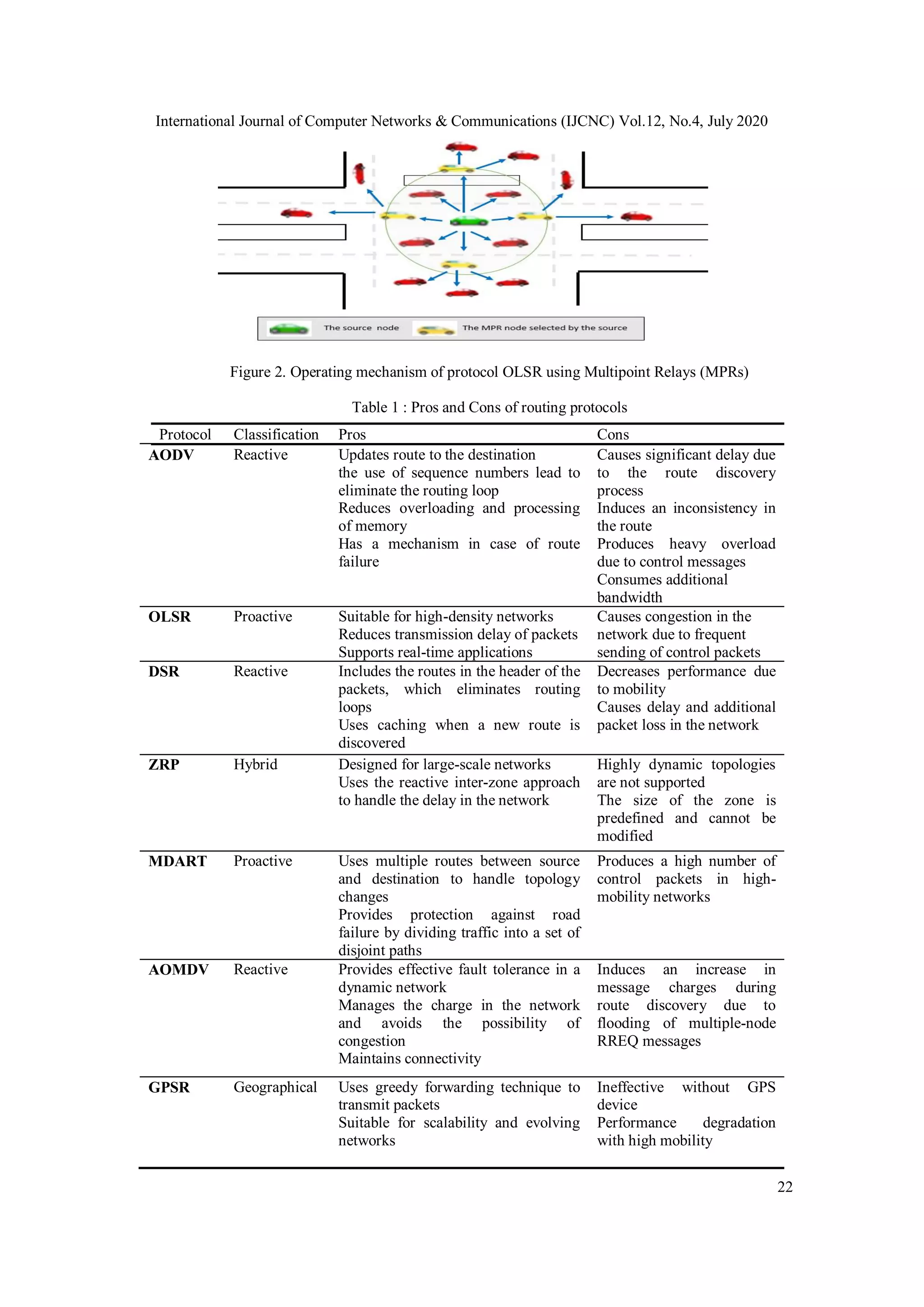
![International Journal of Computer Networks & Communications (IJCNC) Vol.12, No.4, July 2020
23
Ad hoc on-demand multipath routing (AOMDV)[12] is an improvement to the protocol
AODV that allows for the discovery of several routes between the source and destination. It
guarantees a route without a loop, based on sequence numbers. The maintained paths correspond
to the maximum value of the sequence number to the destination, and all information about the
next hop is kept for the destination. The route discovery process is restarted if all paths fail.
Dynamic source routing (DSR) [13] was designed for ad-hoc multi-hop networks, and forms
routes when a source node wants to send a packet to the destination. In addition, it uses the
concept of source routing. The two-path mechanisms of AODV are applied in DSR, and each
node maintains a cache of routes containing the route leading to the destination nodes.
Figure 3. Operating mechanism of Reactive protocol
2.1.3.Hybrid routing protocols
The zone routing protocol (ZRP) [14] was one of the first hybrid protocols used in large-scale
networks [15]. Route discovery is performed by a limited number of route searches, using inter-
one and intra-zone routing to provide route discovery and route maintenance (see Figure 4).
Using reactive routing performed by the inter-zone routing protocol (IERP), which keeps nodes
within the zone, it makes a single route request that can result in multiple route responses without
overloading resources or loop problems. Proactive routing uses the intra-zone routing protocol
(IARP), which updates the status of the network and maintains routes to nodes outside of the
routing area. As a result, reactive routing reduces the network overhead and manages the delay
caused by reactive routing.
2.2.Geographic routing protocols
Greedy perimeter stateless routing (GPSR) [16] based on the geographical position obtained
using a positioning system such as GPS. When transmitting packets, each vehicle periodically
broadcasts beacon packets to its direct neighbors, and maintains a list containing its own position,
the position of its destination and the position of its direct neighbors (one hop), as shown in
Figure 5.](https://image.slidesharecdn.com/12420cnc02-200817043122/75/PERFORMANCE-ANALYSIS-OF-ROUTING-PROTOCOLS-WITH-ROADSIDE-UNIT-INFRASTRUCTURE-IN-A-VEHICULAR-AD-HOC-NETWORK-5-2048.jpg)
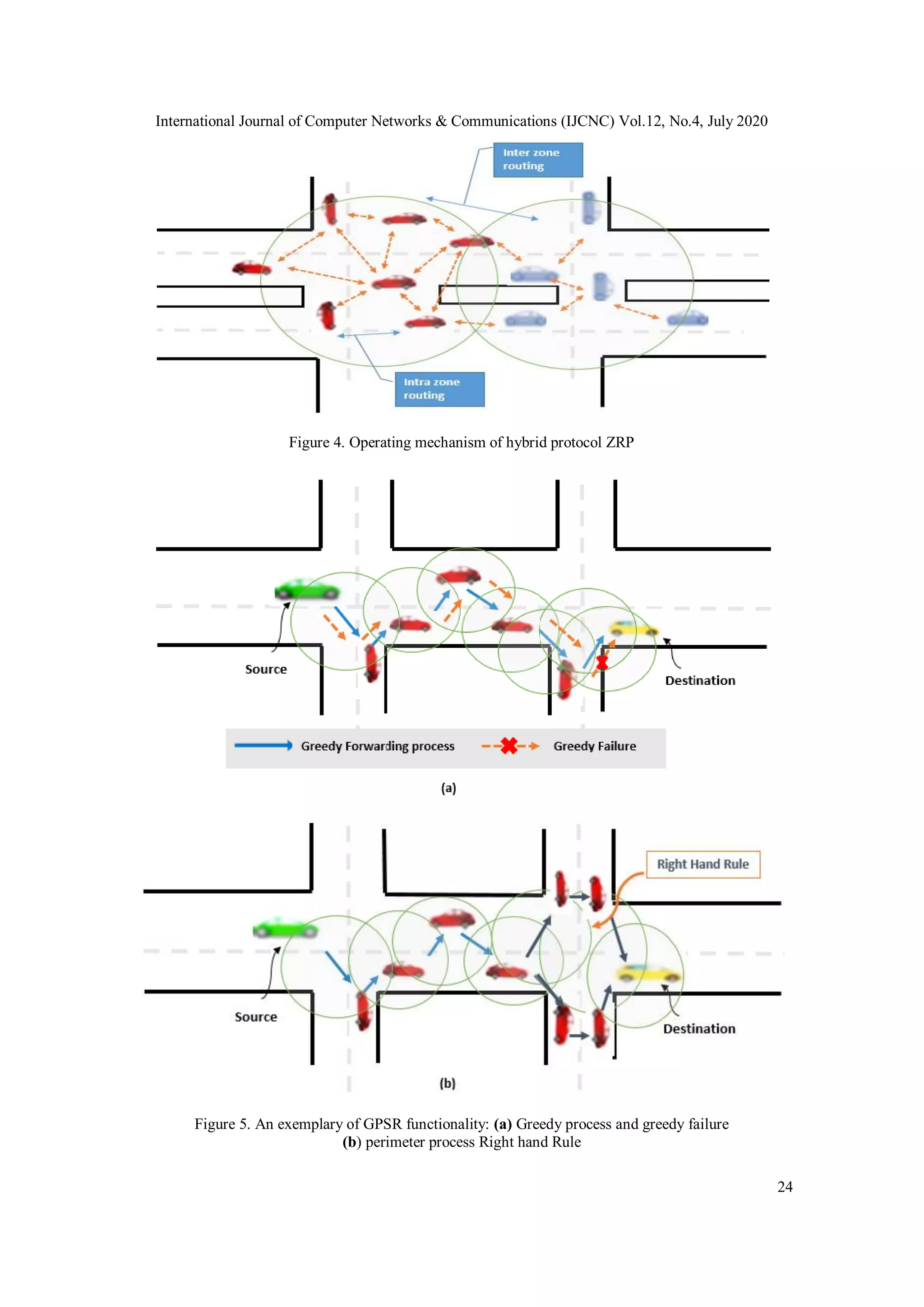
![International Journal of Computer Networks & Communications (IJCNC) Vol.12, No.4, July 2020
25
It uses two methods of packet transmission. Greedy forwarding is the first strategy, and this is
applied to choose the next optimal vehicle (next hop) that will take over the routing, by selecting
the nearest neighbor that is closest to the destination. However, if the transmitter node is a shorter
distance from the destination than all its neighbors, the second strategy of perimeter forwarding is
applied. This involves using the right-hand rule by routing around the perimeter until a node
close to the destination is reached. We assume in our work that the source knows the
geographical location of the destination.
3. RELATED WORKS
The high mobility and instability of vehicles pose new challenges in VANETs. All routing
protocols and perceptions of research aim to enhance the QoS in terms of the packet delivery
ratio (PDR), transmission delay and network overhead. However, it is difficult to choose a
specific routing protocol that works effectively in all VANET environments. One of the most
important surveys was presented in [15]. The authors presented a robust study of VANET
dissemination and a specific discussion of performance and QoS requirements. They then carried
out a classification and comparison of broadcast protocols by selecting several performance
metrics such as the delay, PDR, overhead, throughput, scalability, and network reachability. The
authors acknowledged that the mobility of the nodes, frequent topology changes and breaks that
characterize VANETs make dissemination a major problem as a research topic. In this context,
they discussed the main issues that a researcher may be faced with by examining future
challenges and trends that could take advantage of the most effective mechanisms available. They
also pointed out that despite existing work, there is still a need for QoS development and
optimization, since these studies are based on performance criteria set by researchers according to
their topics of interest. The authors of [17] presented a survey of routing mechanisms based on
geographical protocols. They classified the different protocols into two categories, namely
infrastructure-based and infrastructure-less, the latter of which was classified into basic and
advanced routing protocols. In addition, the authors provided an analysis of VANET
architectures and various VANET applications. They then presented a comparative study that
took into consideration different parameters and variants of greedy forwarding to transmit
packets using V2V and V2I approaches. The majority of protocols used GPSR as the base
protocol in all simulation scenarios, and the authors suggest that the evaluation of protocols
should be performed in these environments. In this context, numerous works have shown many
motivations requirements based on the geographic information of vehicles in a VANET. In
summary, the overall goal of the various authors of these surveys is to help engineers and
researchers to improve vehicle network applications for driver safety and comfort.
Many works have also been dedicated to comparing the performance of routing protocols,
considering various performance metrics and parameters such as mobility models. The authors of
[18] presented one of these studies, and compared the performance of two protocols OLSR and
AODV in urban road scenarios, based on two roads and several intersections. Four metrics are
considered: the PDR, the overhead, the throughput, and the E2E delay. The authors used CBR for
the data traffic in the two density variation scenarios over transmission ranges of 250 and 500 m.
The results showed that the routing costs and delays in both protocols increased with density. It
was therefore concluded that the AODV and OLSR protocols are impractical for a VANET with
a high density of vehicles. In the same context, the authors of [19] presented a comparative study
of the AODV, OLSR and DSR protocols in urban and highway scenarios, in terms of the PDR
and E2E delay. Their goals were to achieve robust and easy communication between vehicles for
driver safety. The AODV protocol performed well in terms of PDR as function of the density
variation. Another study involving a performance evaluation of routing protocols adapted for
VANET was presented by the authors of [20]. They evaluated the impacts of the speed and
density of vehicles using various metrics. The AODV, AOMDV, DSR, ZRP, DSDV and OLSR](https://image.slidesharecdn.com/12420cnc02-200817043122/75/PERFORMANCE-ANALYSIS-OF-ROUTING-PROTOCOLS-WITH-ROADSIDE-UNIT-INFRASTRUCTURE-IN-A-VEHICULAR-AD-HOC-NETWORK-7-2048.jpg)
![International Journal of Computer Networks & Communications (IJCNC) Vol.12, No.4, July 2020
26
protocols were simulated using the NS2.35 and SUMO simulator with a CBR data traffic model
and various numbers of nodes in a VANET and a MANET. The simulation results showed that
the AODV protocol achieved good performance in terms of delay and other performance metrics,
unlike in [19], where OLSR outperformed AODV in terms of the E2E delay. The authors
concluded that the applicability of MANET routing protocols to a VANET is unsatisfactory, due
to the high mobility and low node density. The performance results presented in all these studies
provide an adequate overview of the applicability of routing protocols and data integrity to
VANETs, and thus could help in designing improvements to the existing protocols.
The studies discussed above [18]–[20] evaluate the performance of VANET networks by
considering only the V2V communication mode and CBR data traffic. In contrast, other studies
have processed communications using RSU and TCP data traffic. In this context, the authors
of[21] present QoS studies of the AODV and DSDV protocols using the two communication
modes of V2V and V2I for different RSU relay placements in urban scenarios, based on CBR
data traffic. The performance of AODV in all scenarios was better than that of DSDV in terms of
the sending, receiving and forwarding throughput and the data loss. The authors observed that the
scenario using a strategy with RSUs placed on both sides of the road provided better performance
and hence better data transmission. The researchers in [22] analyzed the AODV protocol with a
new data transmission scheme for communicating with enhanced RSU. The purpose of this new
data transmission scheme was to discover routes in order to reduce overhead and improve QoS.
The results showed that the proposed method improved significantly the performance compared
to AODV protocol, in terms of the PDR and overhead. The authors of [23] considered two types
of data traffics in an urban environment depending on certain metrics. Their analysis of various
routing protocols addressed many of the problems of V2V communication and will be consistent
with future simulation environments for VANETs. The researchers in [24] used TCP with CBR
data traffic to evaluate the AOMDV protocol in terms of the PDR, E2E delay, packet loss ratio
and throughput. The AOMDV protocol was designed to efficiently transmit data with respect to
the AODV protocol in a VANET network. The multipath AOMDV protocol minimized the delay
and packet loss ratio and maximized the PDR, while enhancing the throughput. To our
knowledge, no attempt has been made to study and evaluate the performance of RSUs with TCP
and CBR traffic, in an urban environment; this is a problem of interest for VANETs, since it
involves many problems and complications that need to be addressed.
The motivation for carrying out this survey is to bring forth an up-to-date global summary of
routing protocols in VANETs, and a performance evaluation of an enormous range of a routing
mechanism. Unlike other surveys, our work evaluates and compares the most popular and
efficient routing protocols with significant description. To the best of our knowledge, there is a
lack of simulation studies or comprehensive research that evaluates and compares routing
protocols using IEEE 802.11p technology. Thus, a study of the impact of varying data traffic
conditions while exchanging information with RSUs is required. This paper aims is to describe
and analyze the performance of seven popular and important routing protocols considering RSUs
in an urban area with two types of data traffic and different QoS performance metrics. This
analysis can be useful for researches and engineers when developing practical applications and
when selecting the most appropriate routing protocols while satisfying the constraints of VANET
networks.](https://image.slidesharecdn.com/12420cnc02-200817043122/75/PERFORMANCE-ANALYSIS-OF-ROUTING-PROTOCOLS-WITH-ROADSIDE-UNIT-INFRASTRUCTURE-IN-A-VEHICULAR-AD-HOC-NETWORK-8-2048.jpg)
![International Journal of Computer Networks & Communications (IJCNC) Vol.12, No.4, July 2020
27
4. PERFORMANCE EVALUATION
4.1. Model of mobility
The vehicle mobility model has been widely used in the literature, due to its ability to provide an
accurate model for VANET nodes. According to the authors of [25], the integration of a mobility
model can produce significant results. In our work, we use the VanetMobiSim [26] generator, as
it provides a high level of realism in our simulation scenarios. Mobility generators can be
classified into two types: macroscopic and microscopic. The macroscopic model captures the
traffic conditions that influence vehicular traffic, for example the characteristics of a road (one or
two-ways, speed, and numbers of lanes), the topology of the road network, traffic lights at
intersections and signs, etc. Although this type of simulation is more complex, it is very useful
and is necessary when studying the interactions of vehicles with infrastructure. Following
[27],we select the mobility model, Intelligent Driver Model with Lane Change model (IDM-LC),
which takes into account traffic lights, intersections, vehicle speeds and lane changes, and is
therefore the most convenient for our work. Table3 shows the various parameters used on the
experiment evaluation in VANET.
4.2. Parameters of scenarios
In our simulation, we compare different ad hoc routing protocols in an urban environment using
the NS-2 network simulator depending on the type of traffic required by the user (voice, data or
video). Which are the file transfer protocol FTP/TCP and the constant bit rate protocol
CBR/UDP. A random graph of streets is generated by VanetMobiSim, with a variable number of
vehicles and a topology network with nine RSUs. In order to increase the success rate for packet
delivery and decrease the average delay, we use IEEE802.11p, which is suitable for a VANET.
The main simulation parameters and network characteristics describing the scenario are presented
in Table 2. The macroscopic and microscopic mobility model parameters are presented in Tables
3 and 4 [28].
Table 2: Values of the different parameters used in the simulation
Parameters used for traffic model Value
Background traffic CBR/UDP
FTP/TCP
Number of connections 10,15,20,25,30,35,40
Packet size 512 packets
Packet rate 8 packets/s
Simulation time 300 s
Simulation parameters and network characteristics
Simulator version NS-2.35
MAC & PHY layer protocols IEEE 802.11p
Transmission range 250 m
Propagation model Two-ray ground
Type of antenna OmniAntenna
Parameters used for mobility model
Dimensions of the simulation area 1000 x 1000 m²
Number of vehicles 50 vehicles
Mobility model IDM-LC
Traffic direction Multidirectional](https://image.slidesharecdn.com/12420cnc02-200817043122/75/PERFORMANCE-ANALYSIS-OF-ROUTING-PROTOCOLS-WITH-ROADSIDE-UNIT-INFRASTRUCTURE-IN-A-VEHICULAR-AD-HOC-NETWORK-9-2048.jpg)
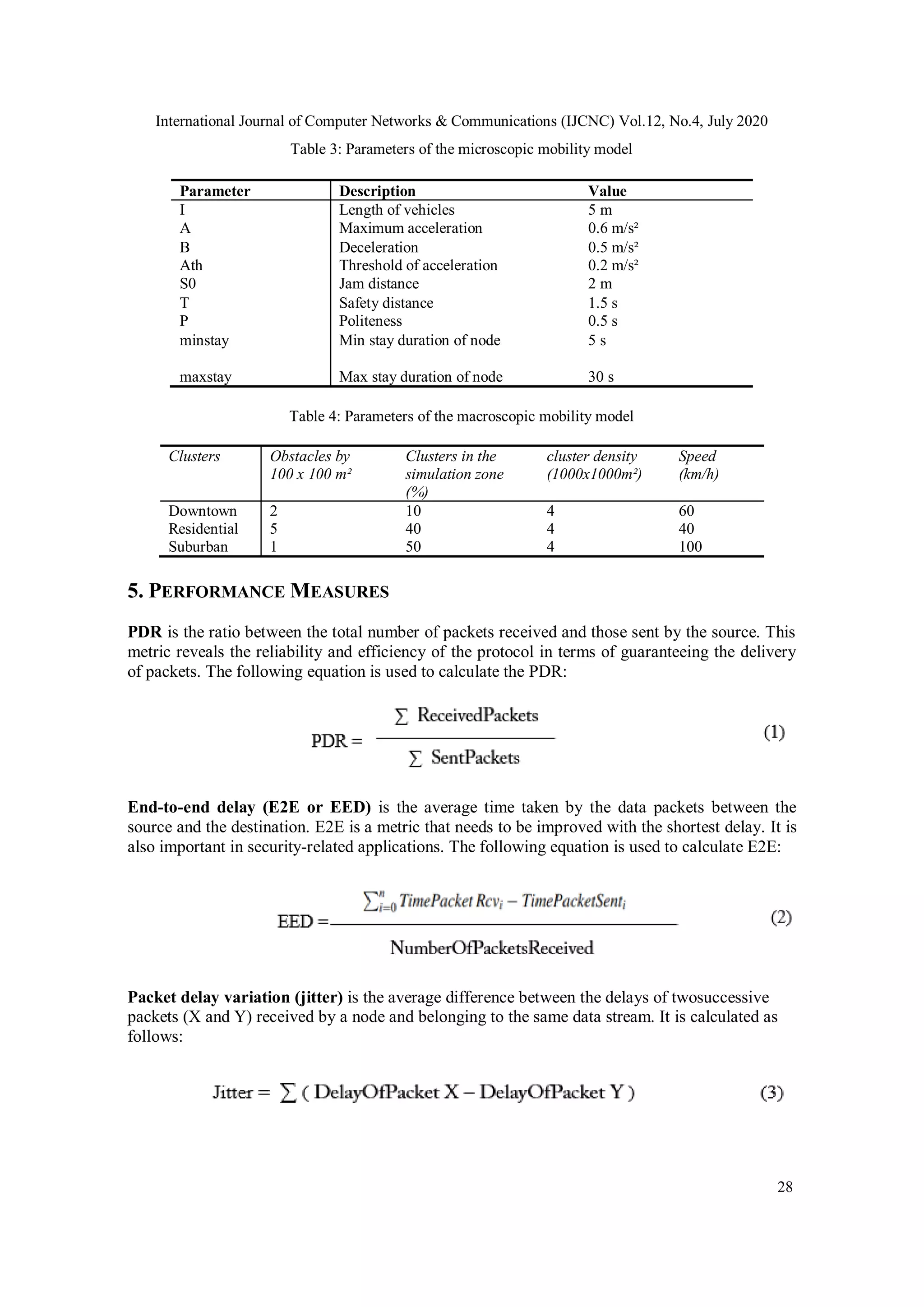
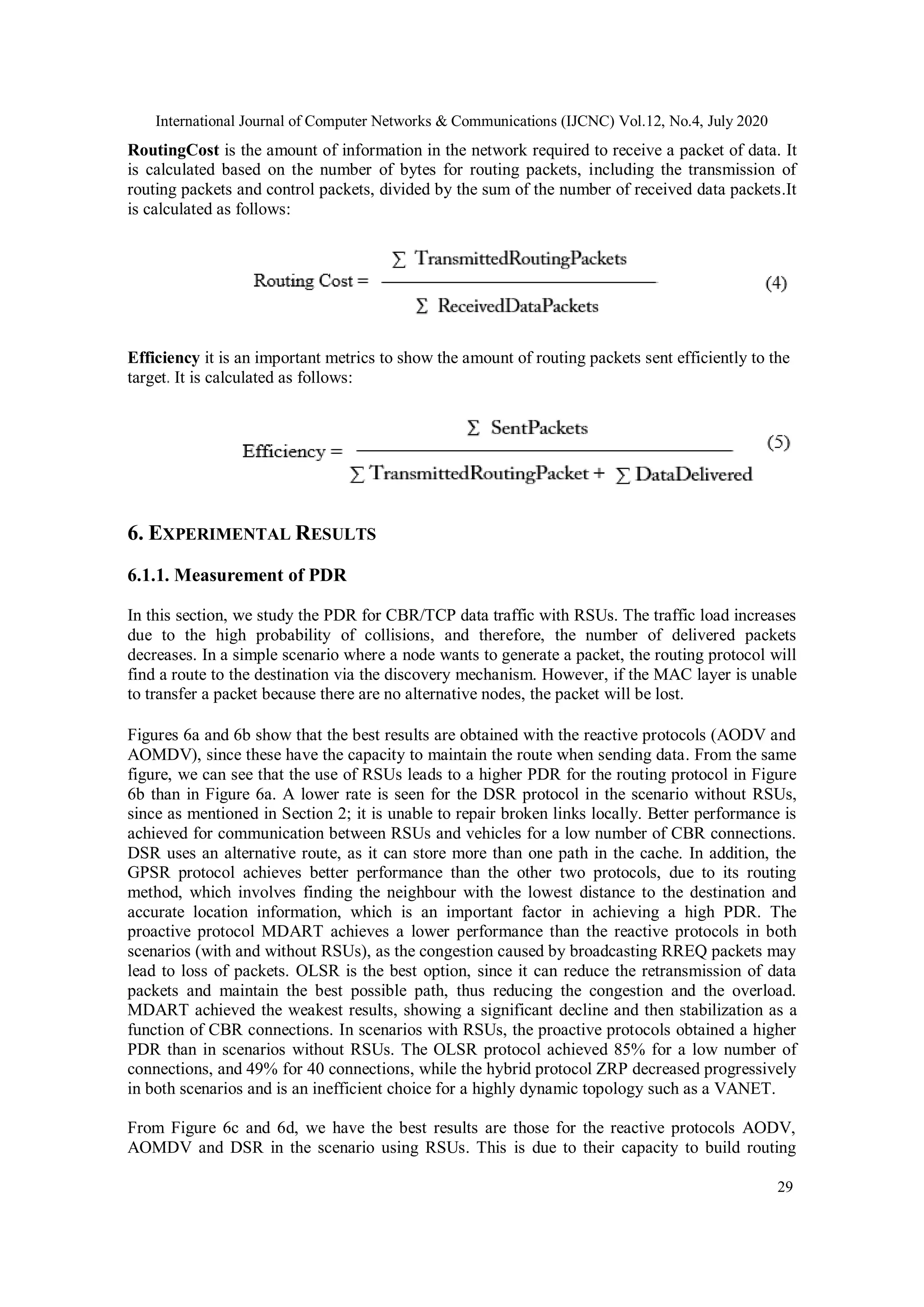
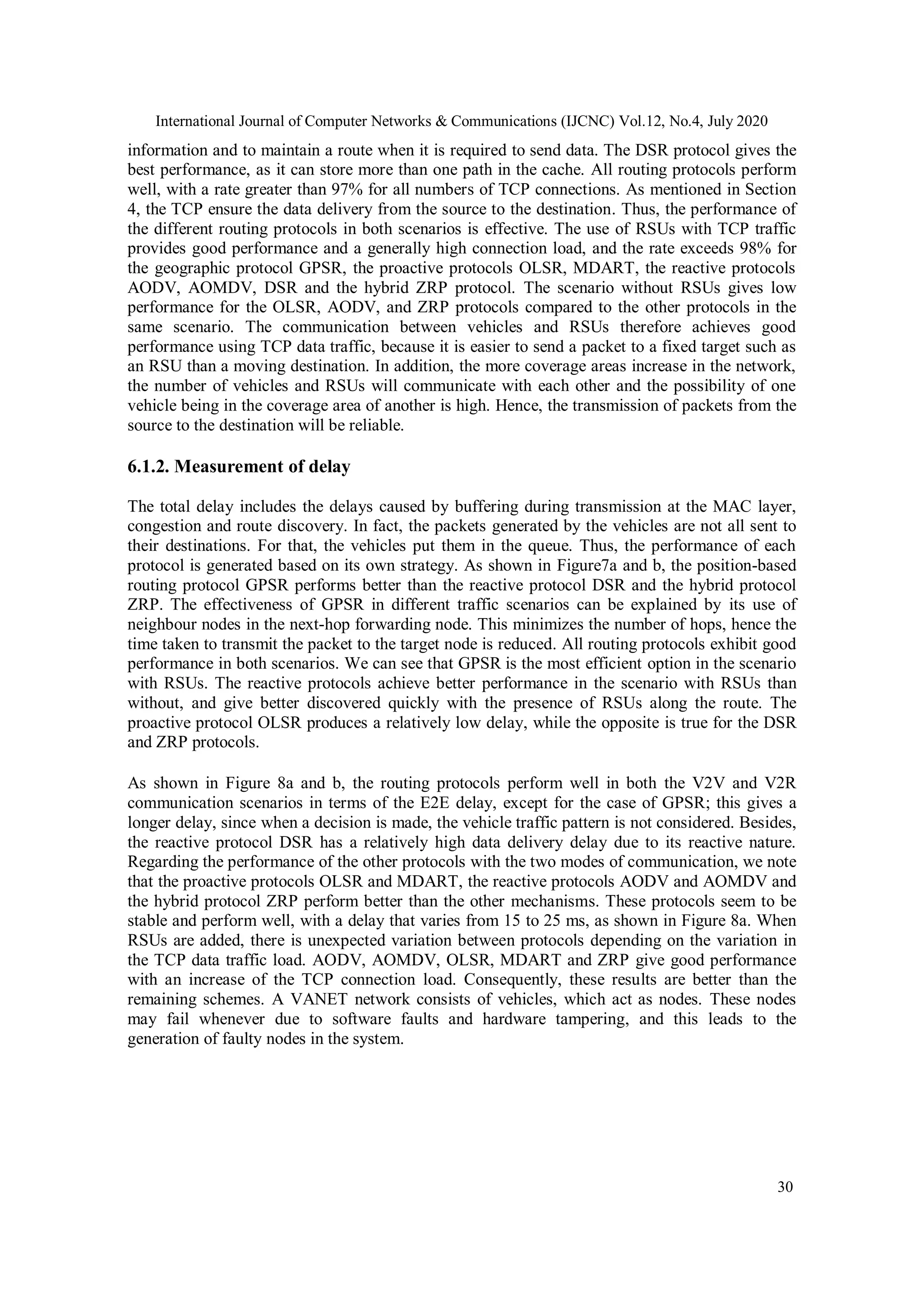
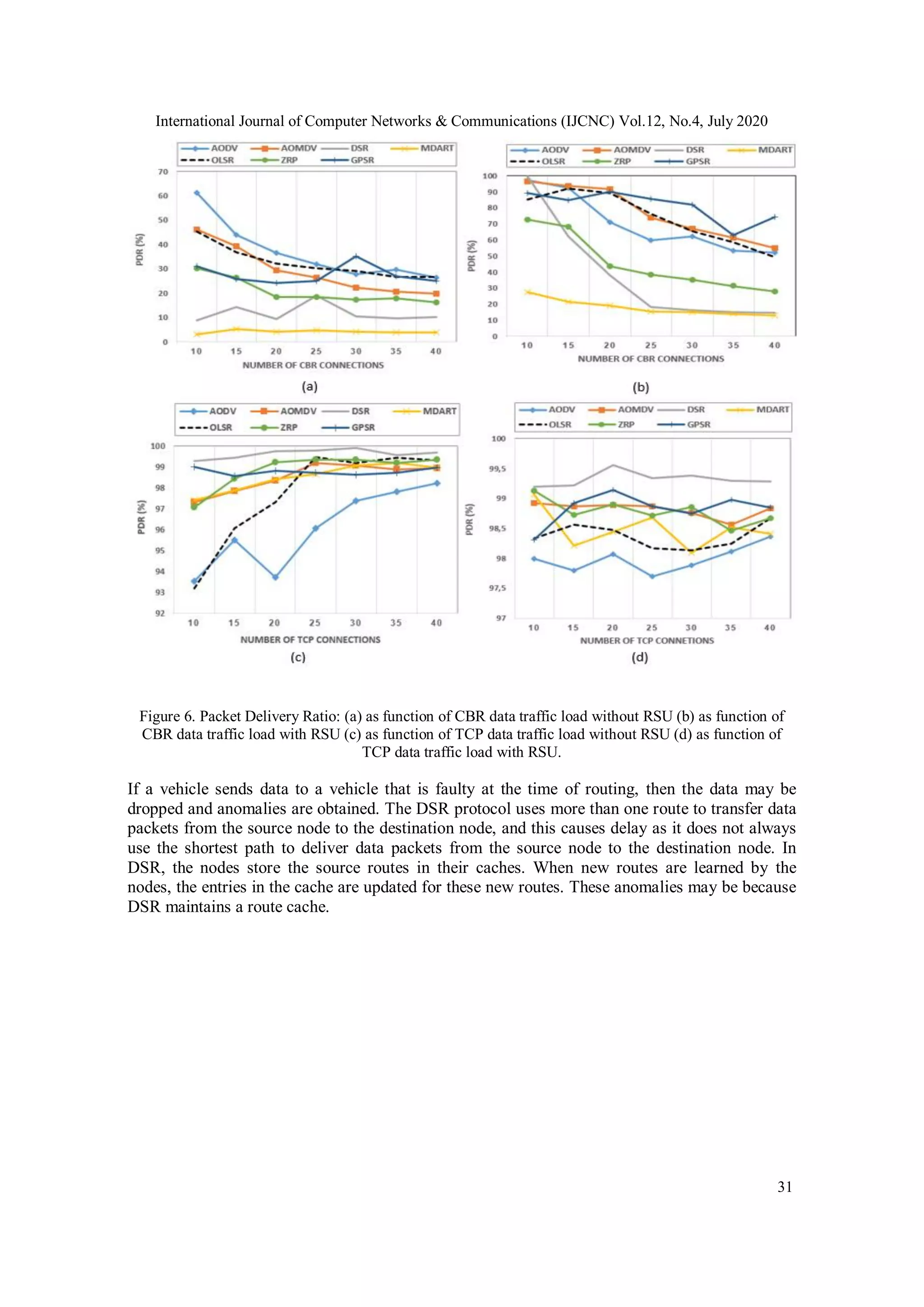
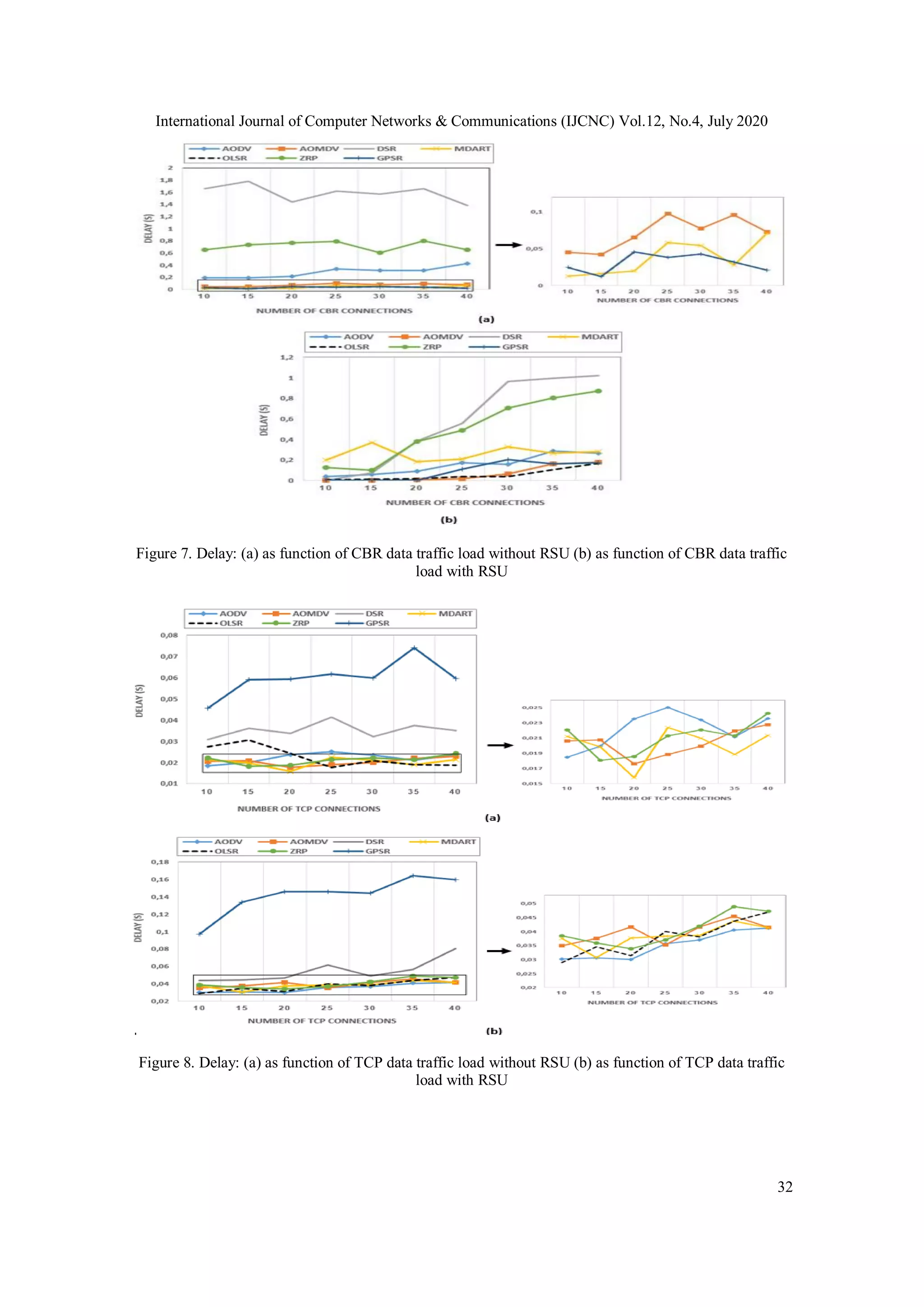
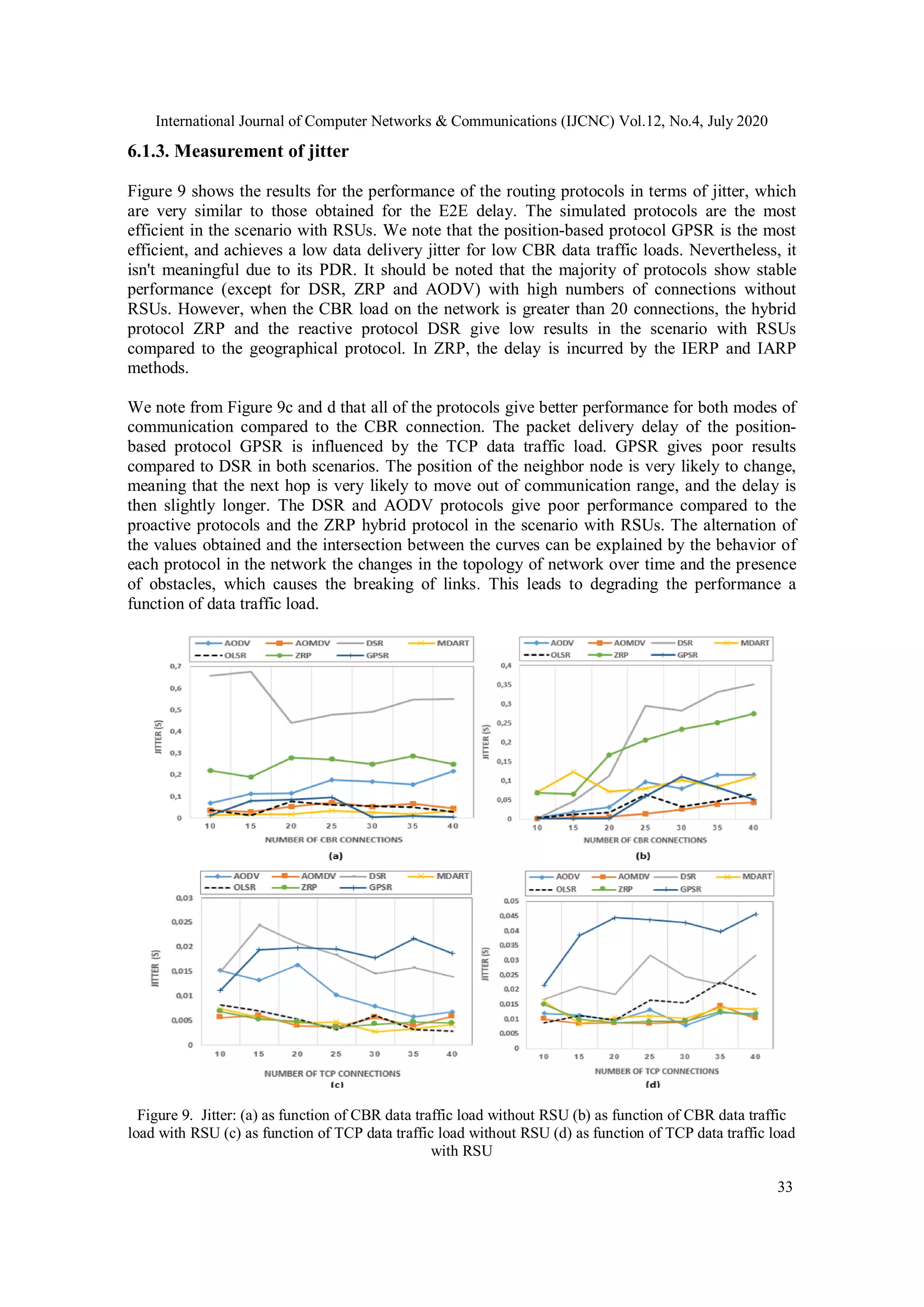
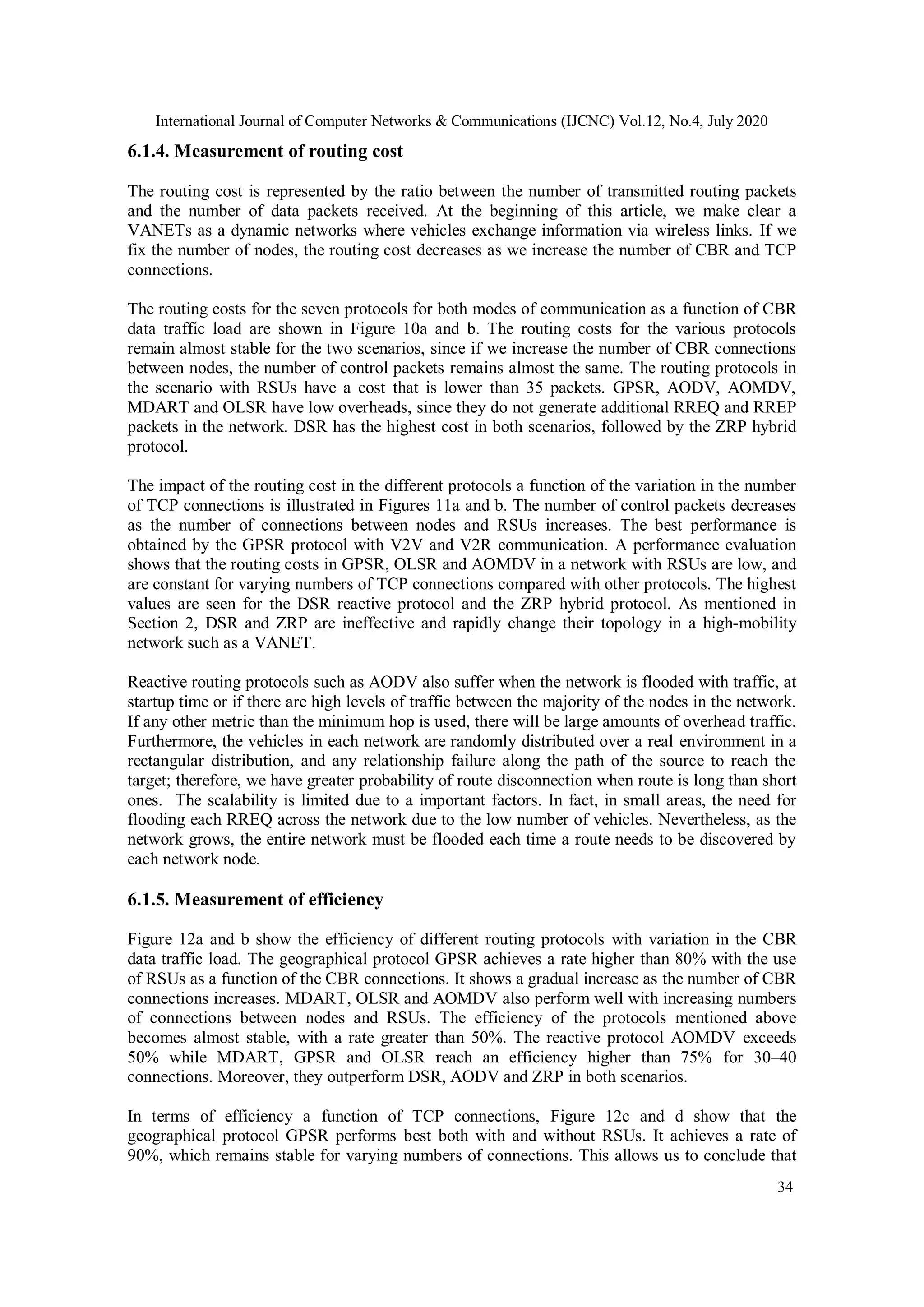
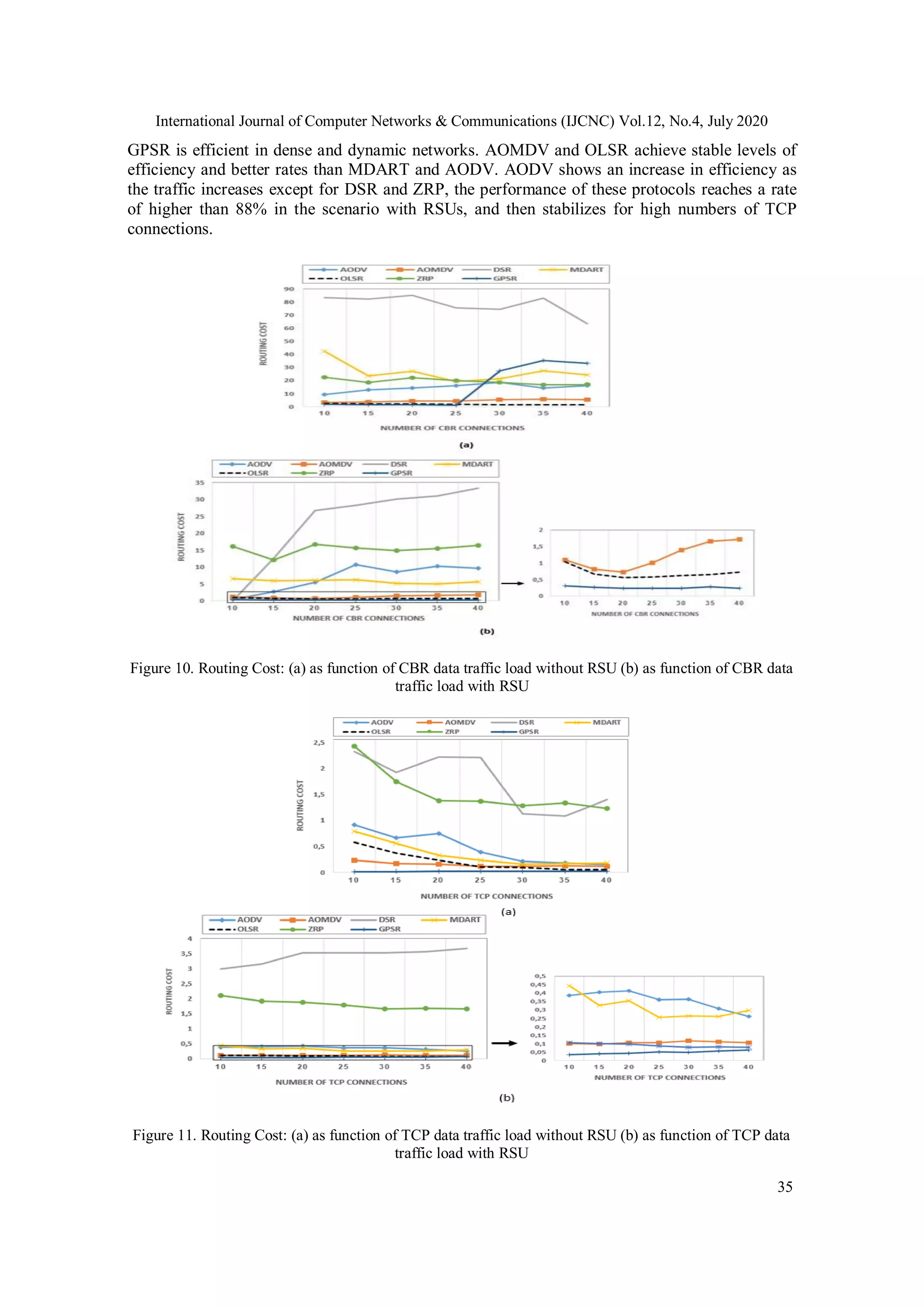

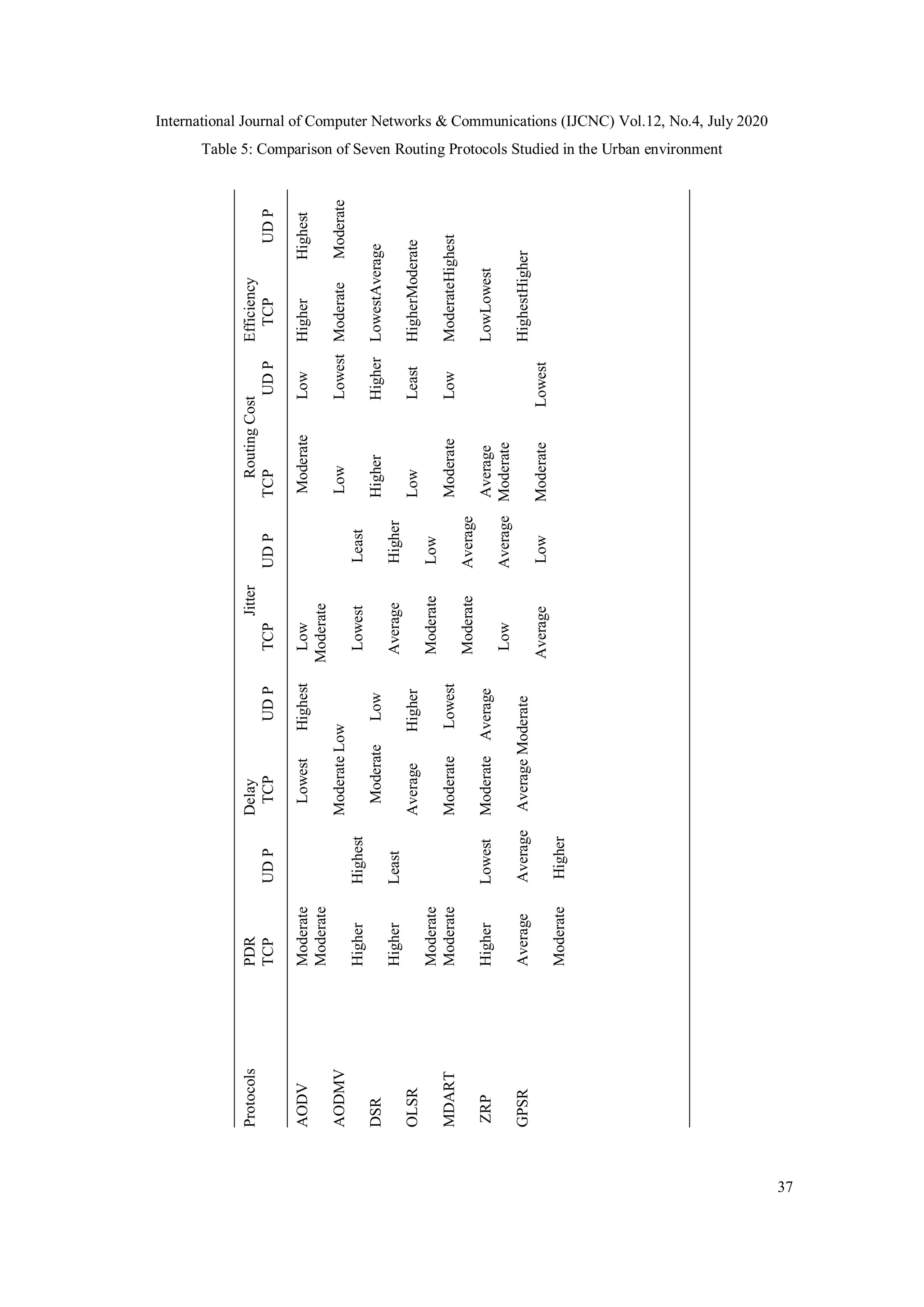
![International Journal of Computer Networks & Communications (IJCNC) Vol.12, No.4, July 2020
38
The DSR and GPSR protocols incur significant delays for CBR and TCP connection loads, due to
high vehicle speeds and loss data packets. The vehicles can therefore be very far apart, leading to
long delays. These observations allowed us to realize the importance of routing messages using
RSUs along the way. In the concrete case of an urban environment, vehicles tend to drive at
different speeds and are faced with several obstacles; they should therefore be able to change the
route for each CBR and TCP connection.
8. CONCLUSIONS
This paper presents a comprehensive research of the various categories of routing protocols in
VANET networks, and describes a simulation model based on two types of data traffics. A wide
variety of routing protocols are compared in realistic environments under different conditions in
terms of their QoS. In view of the problems and difficulties encountered in VANET networks, we
studied the response of these routing protocols for V2R communication, using RSU fixed
infrastructures and V2V communications. The aim of this work is to provide researchers and
designers with a better analysis and comparison in order to support the QoS and to give an
interesting and practical reference for future works. Based on the analysis of the results, it can be
deduced that the use of RSUs has improved the performance of routing protocols compared to
communication without infrastructure. The location-based protocol performs well compared to
other protocols in both environments. Proactive protocols give better results in terms of time and
jitter, due to their proactive natures. In addition, we found that reactive protocols performed well
in terms of PDR, routing cost and efficiency, compared to the hybrid ZRP protocol, except for
the DSR protocol, which showed performance degradation for some simulation cases. In
perspective, we will be moving towards an improvement to geographical versions with other
types of traffic and other simulation environments.
CONFLICTS OF INTEREST
The authors declare no conflict of interest.
REFERENCES
[1] “ISO 24102-6:2018, Intelligent transport systems — Communications access for land mobiles
(CALM) — ITS station management — Part 6: Path and flow management.”
[2] Campolo, C., Molinaro, A., & Scopigno, R. (Eds.) (2015) Vehicular Ad Hoc Networks: Standards,
Solutions, and Research. Springer International Publishing.
[3] Campolo, C., Molinaro, A., & Scopigno, R. (2015) Vehicular Ad Hoc Networks: Standards,
Solutions, and Research. Springer.
[4] Da Cunha, F. D., Boukerche, A., Villas, L., Viana, A. C., & Loureiro, A. A. F. (2014) “Data
communication in VANETs: A survey, challenges and applications,” INRIA Saclay; INRIA, report.
[5] Vegni, A. M., Cusani, M. B., & Cusani, R. (2013) “Smart vehicles, technologies and main
applications in vehicular ad hoc networks,” Veh. Technol. Deploy. Appl.
[6] Jacquet, P. “Optimized link state routing protocol (OLSR)”.
[7] Caleffi, M. & Paura, L. (2011) “M-DART: Multi-path dynamic address routing,” Wirel. Commun.
Mob. Comput., Vol. 11, No. 3, pp. 392–409.
[8] Ullah, K., Santos, L. M., Ribeiro, J. B., & Moreira, E. D. S. (2016) “SADP: A lightweight beaconing-
based commercial services advertisement protocol for vehicular ad hoc network,” in Ad-hoc, Mobile,
and Wireless Networks, pp. 279–293.
[9] Das, S. R., Belding-Royer, E. M., & Perkins, C. E. “Ad hoc on-demand distance vector (AODV)
routing.”
[10] Haerri, J. (2006) “Performance comparison of AODV and OLSR in VANETs urban environments
under realistic mobility patterns”.](https://image.slidesharecdn.com/12420cnc02-200817043122/75/PERFORMANCE-ANALYSIS-OF-ROUTING-PROTOCOLS-WITH-ROADSIDE-UNIT-INFRASTRUCTURE-IN-A-VEHICULAR-AD-HOC-NETWORK-20-2048.jpg)
![International Journal of Computer Networks & Communications (IJCNC) Vol.12, No.4, July 2020
39
[11] Ferreiro-Lage, J. A., Gestoso, C. P., Rubiños, O., & Agelet, F. A. (2009) “Analysis of unicast routing
protocols for VANETs,” in 2009 Fifth International Conference on Networking and Services, pp.
518–521.
[12] Marina, M. K. & Das, S. R. (2001) “On-demand multipath distance vector routing in ad hoc
networks,” in Proceedings of the Ninth International Conference on Network Protocols. ICNP 2001,
pp. 14–23.
[13] Johnson, D. B. & Maltz, D. A. (1996) “Dynamic source routing in ad hoc wireless networks,” in
Mobile Computing, Imielinski, T., & Korth, H. F. (Eds.). Boston, MA: Springer US, pp. 153–181.
[14] Haas, Z., Pearlman, M., & Samar, P. “The zone routing protocol (ZRP) for ad hoc networks.”
[15] Mchergui, A., Moulahi, T., Alaya, B., & Nasri, S. (2017) “A survey and comparative study of QoS
aware broadcasting techniques in VANET,” Telecommun. Syst., Vol. 66, No. 2, pp. 253–281.
[16] Karp, B. & Kung, H. T. (2000) “GPSR: Greedy perimeter stateless routing for wireless networks,” in
Proceedings of the Sixth Annual International Conference on Mobile Computing and Networking,
New York, NY, USA, pp. 243–254.
[17] Kumar, S. & Verma, A. K. (2015) “Position based routing protocols in VANET: A survey,” Wirel.
Pers. Commun., Vol. 83, pp. 2747–2772.
[18] Jaiswal, R. K. & Jaidhar, C. D. (2015) “An applicability of AODV and OLSR protocols on IEEE
802.11p for city road in VANET,” in Internet of Things, Smart Spaces, and Next Generation
Networks and Systems, pp. 286–298.
[19] Singh, P. K. (2011) “Simulation based analysis of adhoc routing protocol in urban and highway
scenario of VANET”.
[20] Purohit, K. C., Dimri, S. C., & Jasola, S. (2017). “Performance evaluation of various MANET routing
protocols for adaptability in VANET environment,” Int. J. Syst. Assur. Eng. Manag., Vol. 8, No. 2,
pp. 690–702.
[21] Ali, F., Shaikh, F. K., Ansari, A. Q., Mahoto, N. A., & Felemban, E. (2015) “Comparative analysis of
VANET routing protocols: On road side unit placement strategies,” Wirel. Pers. Commun., Vol. 85,
No. 2, pp. 393–406
[22] Yang, L. & Liu, H. (2016) “A data transmitting scheme based on improved AODV and RSU-assisted
forwarding for large-scale VANET,” Wirel. Pers. Commun., Vol. 91, No. 3, pp. 1489–1505.
[23] Smiri, S., Boushaba, A., Abbou, R. B., & Zahi, A. (2018) “Geographic and topology based routing
protocols in vehicular ad-hoc networks: Performance evaluation and QoS analysis,” in 2018
International Conference on Intelligent Systems and Computer Vision (ISCV), pp. 1–8
[24] Bondre, V. & Dorle, S. (2015) “Design and performance evaluation of AOMDV routing protocol for
VANET,” in 2015 International Conference on Computer, Communication and Control (IC4), pp. 1–
4.
[25] Choffnes, D. R. & Bustamante, F. E. (2005) “An integrated mobility and traffic model for vehicular
wireless networks,” in Proceedings of the Second ACM International Workshop on Vehicular Ad
Hoc Networks, New York, NY, USA, pp. 69–78.
[26] “VanetMobiSim - Newcom | Institut Eurecom | Politecnico di Torino.” [Online]. Available:
http://vanet.eurecom.fr/.
[27] Rahman, M. H. & Rahman, M. U. (2014) “Realistic vehicular mobility impact of FTM , IDM , IDM-
IM and IDM-LC on VANETs”.
[28] Harri, J. & Fiore, M. (2006) "VanetMobiSim–Vehicular ad hoc network mobility extension to the
CanuMobiSim framework," Institut Eurécom Department of Mobile Commu, Vol. 6904, p. 1–19.](https://image.slidesharecdn.com/12420cnc02-200817043122/75/PERFORMANCE-ANALYSIS-OF-ROUTING-PROTOCOLS-WITH-ROADSIDE-UNIT-INFRASTRUCTURE-IN-A-VEHICULAR-AD-HOC-NETWORK-21-2048.jpg)